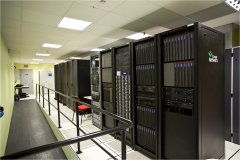The HFI DPC
The HFI DPC has been organized into different "Levels": 1, 2, 3, 4 and "S". In brief, during operations, L1 feeds the database resulting in time-ordered information (TOI) objects. L2 is the core of the processing, which turns TOIs into clean calibrated sky maps. L3 transforms these maps at specific frequencies into more scientific products, like catalogues, maps and spectra of astrophysical components. L3 can rely on simulation provided by the LS, while L4 refers to delivering the DPC products to ESA. This processing relies on dedicated software and hardware infrastructures developed pre-launch.
The data processing applied for the "Early Planck results" series of publications was described in Planck early paper VI . The Template:REF TO P03 and its co-papers provide the reference for the processing done for the 2013 Data release. An Annex of P03 specifies what had been done (and resulting characteristics) for the "Intermediate Planck results" series of publications.
Contents
- 1 Level 1: building the reference database during flight operations
- 2 Level 2: converting temporal information into clean calibrated maps
- 3 Level 3: Basic analyses of (Level 2) Frequency maps
- 4 Level 4 : Delivering results
- 5 Level S : A common HFI/LFI simulation software
- 6 HFI DPC Infrastructures
- 7 HFI Unit Conversion and Colour Correction
Level 1: building the reference database during flight operations[edit]
(L1): consists in receiving the telemetry and ancillary data files and ingesting them into the DPC database. This involves decompressing, in some cases changing data formats, computing the time of individual data samples from the time of the compression slices, but otherwise no processing proper. Other steps are:
- data ingestion (science, HK, ancillary, other?)
- construction of ToS in science data group
- pointing interpolation
- construction of other TOI and ROI objects from AHF, ...
This is further described in the Pre-processing section.
Level 2: converting temporal information into clean calibrated maps[edit]
(L2): this is where the data are processed from timelines into maps. The main processing steps are
- Timeline (or Time-Ordered Information = TOI) processing, which includes conversion from ADUs to engineering units (Volts), demodulation, deglitching, conversion from engineering to physical units (Watts), removal of known systematic effects (non-linearities, 4K lines, Jumps, ring flagging), removal of the instrumental signature (time transfer function), temporal noise Estimation. Details here.
- Pointing and beam of each detector. See section Pointing&Beams.
- map-making & photomoetric calibration: projecting the TOIs onto all-sky maps, etc. See section Map-making.
- Characterisation/validation through angular power spectra. See section PowerSpectra.
- Overal HFI data validation, through difference tests, comparison to detailed simulations, etc., See section HFI-Validation
- The resulting data characteristics are given in section Summary.
Level 3: Basic analyses of (Level 2) Frequency maps[edit]
(L3): This is where the data in the form of frequency maps are converted to catalogues and full sky astrophysical component maps. Much of this is done in common with the LFI DPC, and is further described in the HFI/LFI common sections .
Level 4 : Delivering results[edit]
Level 4 is the "Archive Level". No processing done, but rather exporting, reformating, documenting.
Level S : A common HFI/LFI simulation software[edit]
Level S is the so-called "Simulation Level" software suite common to both consortia, which, given a sky model (generated by the Planck sky model, PSM), detectors pointing and beams, generates the infalling power on each detector. It can also provide a simplified description of eg. the noise. It is further described in the HFI/LFI common section. HFI specific developments (configuration control & MC bench, specific effects like 4K lines, glitches, ADC non-linearity, etc.) are described in the HFI data validation section.
HFI DPC Infrastructures[edit]
The HFI Data Processing Centre can be thought of as a centralized backbone providing hardware and software infrastructures to a relatively large number of geographically distributed groups of developers and other R&D groups in the HFI and LFI core teams.
An overview was given in the HFI data processing paper of the "Planck Early Results" series. In particular:
- Code and configuration management can be found at Planck early paper VI .
- Data management at Planck early paper VI .
- Instrument model (IMO) database at Planck early paper VI .
- Data flow management at Planck early paper VI .
- Hardware at Planck early paper VI .
HFI Unit Conversion and Colour Correction[edit]
This section outlines the unit conversion and colour correction protocol for Planck/HFI. Tables of unit conversion and colour correction coefficients will be included (there is not room for these in the P03d CO-Paper). Some of the checks on the unit conversion and colour correction coefficients will be described here also. Planet colour correction coefficients will be provided here (or perhaps in the joint HFI/LFI section).
(Planck) High Frequency Instrument
Data Processing Center
European Space Agency
House Keeping
Time of Sample
Ring-Ordered Information (DMC group/object)
Attitude History File
EMI/EMC influence of the 4K cooler mechanical motion on the bolometer readout electronics.
(Planck) Low Frequency Instrument
Planck Sky Model
analog to digital converter

